If someone offered you a Fly Graveyard or Cemetery Recipe, would you take it? It doesn’t exactly sound appealing, does it? But actually, this Scottish Fruit Slice is much tastier than the joke name belies!
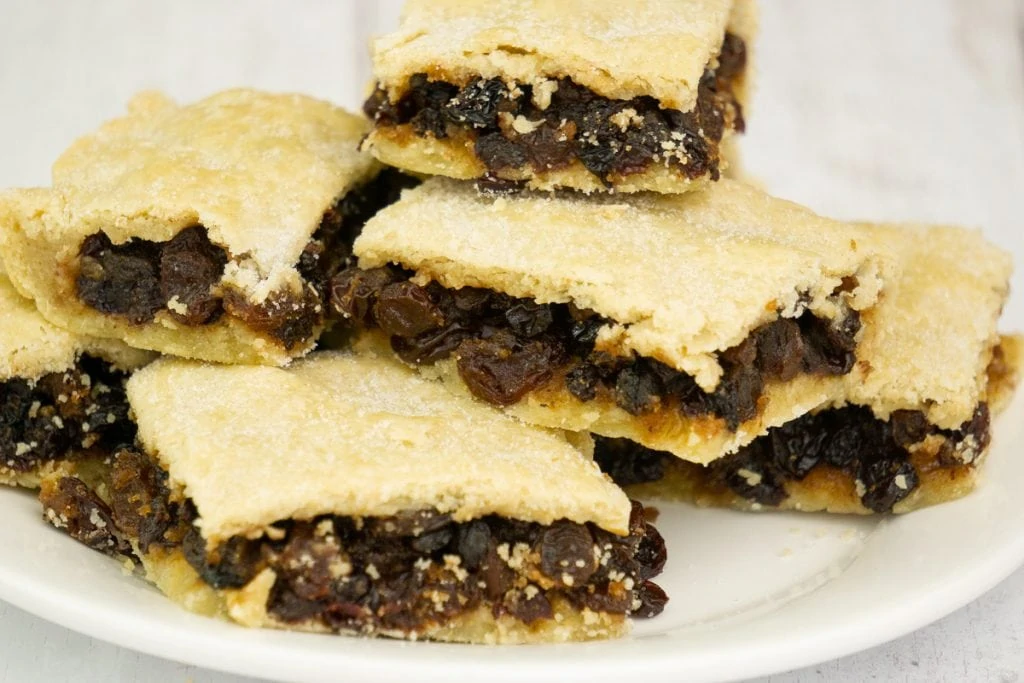
What is a Fly Cemetery?
Whether you know it as or decide to call it Flies’ Graveyard, Flies’ Cemetery, Scottish Fruit Slice Scottish or even Fruit Square, this easy recipe of shortcrust pastry filled with juicy currants and raisins, said to resemble dead flies is one to add to your repertoire. I
t’s quick and simple to make and works well for bake sales or afternoon tea.
The filling of this Fly Cemetery is a bit like a quick and easy version of the sweet mince pies that are eaten around the Christmas holiday season. It’s known all over the United Kingdom but is particularly popular in bakeries across Scotland, which is why we decided that Scottish Scran needed a Fly Cemetery recipe!
And of course, like many of our Scottish baking recipes (we’re looking at you, tablet) you could add a splash of Scottish whisky for an extra Scottish flavour and kick.
Want another easy British slice to make? Try our Almond Slice recipe!
Pin for later!
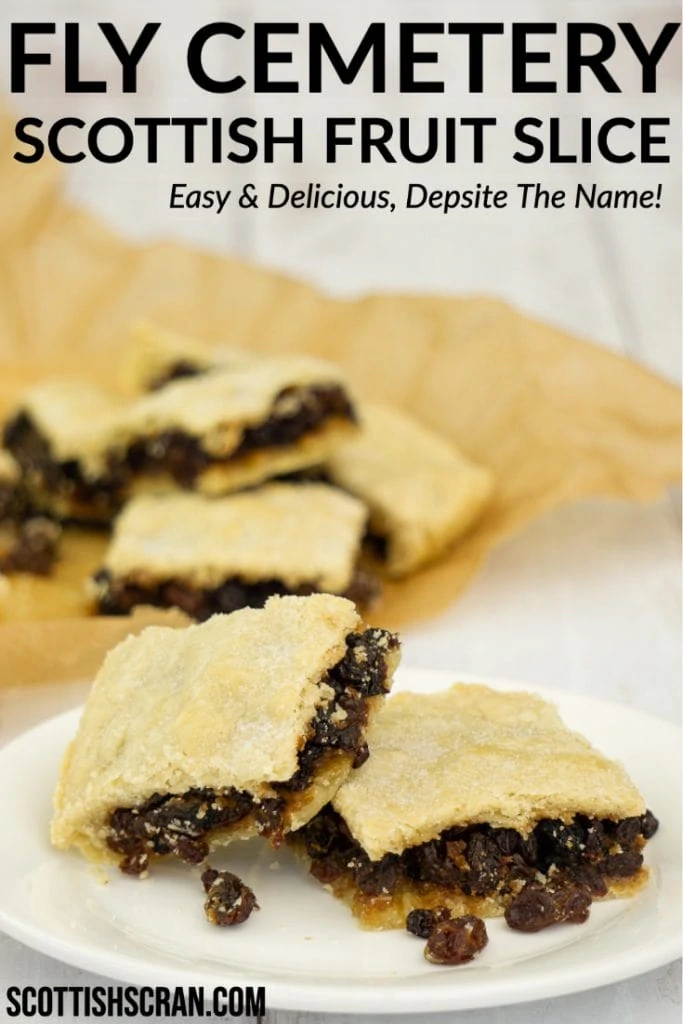
Things you’ll need to make Fly Cemetery
- Baking tray 12x8inches in size. If you use a bigger pan you’ll need to increase the amounts in the recipe. Try adding another half of the recipe again so that you’ll have plenty. Just to be on the safe side!
- A mixer or pastry blender is useful for making the shortcrust pastry but not essential
Ingredients for Fly Cemetery
Short Crust Pastry
You can buy shortcrust pastry if you like but it’s actually pretty simple to make. The key is keeping the butter cold and not handling it too much, but we’ll get into that in the method description.
- 300g plain flour (1 3/4 cups and 2 tbsp)
- 150g cold butter (2/3 cup)
- 75g chilled water (1/3 cup)
Filling
You can really mix and match the filling to your taste. We stuck to currants and raisins but I have seen recipes that include other dried fruits as well. When we were testing the recipe we ran out of raisins at one point and substituted for sultanas and it was still just as delicious!
- 200g currants (1 and 1/3 cups)
- 200g raisins (1 and 1/3 cups)
- 50g butter (3.5 tbsp)
- 100g brown sugar (1/2 cup)
- 3tsp mixed spice
Optional: Caster sugar to sprinkle on top
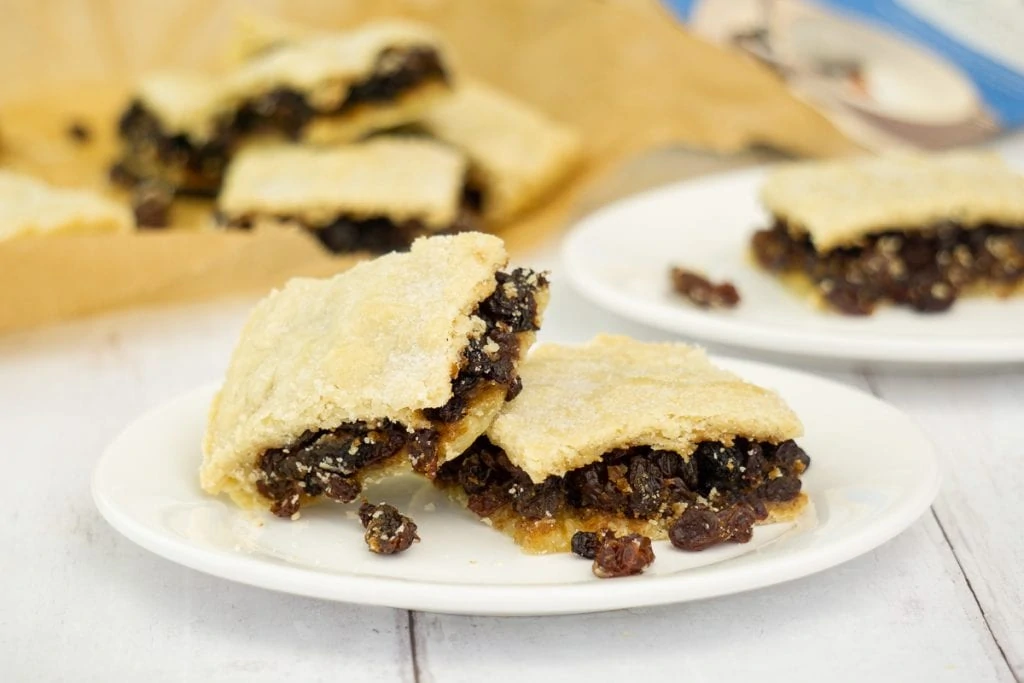
How to make Fly Cemetery – Step by step method
We’ve laid out the detailed method below with some extra tips and step-by-step photos, but you can skip to the end of the post for the short, printable version in the recipe card.
The first step is making the pastry. This fruit slice recipe isn’t complicated but it does need a bit of advanced preparation because you’ll need to chill the pastry before rolling it out, so make sure you give yourself enough time to do this. You can actually make the shortcrust pastry up to two days in advance.
The most important thing when making shortcrust pastry is to use cold butter and cold water, and we don’t just mean water for the tap. I’d recommend putting the small amount of water you need in the fridge to let it chill while you start to put together the rest of the recipe.
Combine the flour and butter to make a breadcrumb-like texture, similar to our scone recipe. The process is called “cutting the butter” into the flour.
There are several ways to do this. If you have a mixer you can put the flour in and then slice the butter in and mix. If not then it’s no problem, you can mix by hand.
The best shortcrust pastry is made with very cold butter and as little handling as possible. Having a pastry blender is a really easy way to do this. If you don’t have one you can slice the butter thinly into the flour and then use two knives to “cut” the butter in as much as you can before using your fingertips to finish rubbing the butter in.
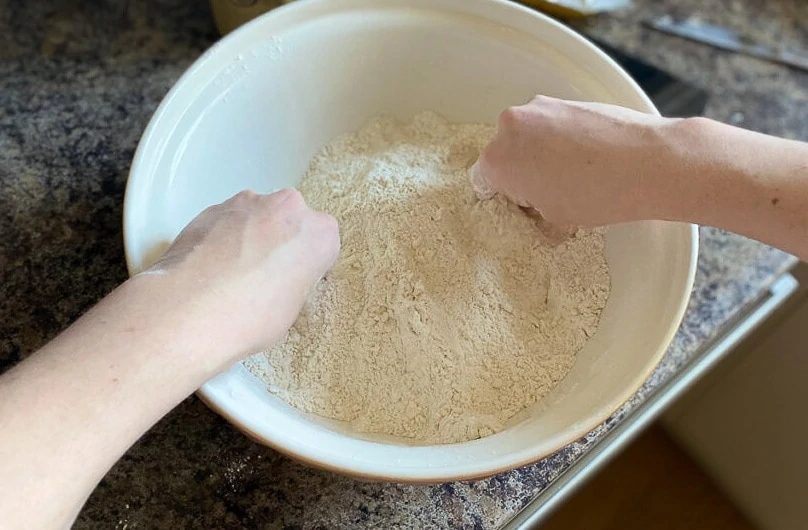
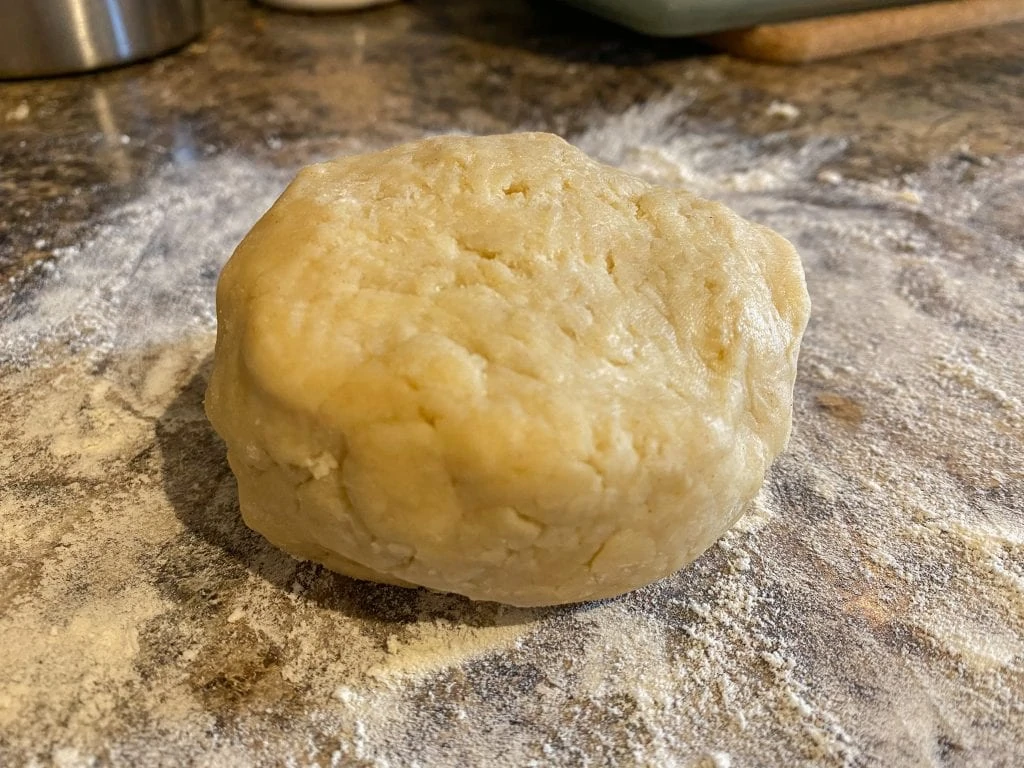
Once you have a breadcrumb texture then tip in the cold water and use a butter knife to stir the mixture to bring it all together as much as possible. Tip on to a lightly floured surface to finish pulling the mixture together. Add a little extra flour if you need to but no more water.
Don’t knead the pastry, try to handle it as little as possible, just as much as you need to bring it into a ball which you can then put in cling film and put in the fridge. Let it rest there for at least 15 minutes but up to 2 days.
In the meantime, you can make the filling.
Preheat the oven to 180 degrees Celsius or 350 Fahrenheit.
Either use a microwave-safe bowl to melt the butter, or put it in a pan on the stovetop. Add the sugar, currants, raisins, and mixed spice, take off the heat and stir to combine. Allow it to cool while you move on to the pastry.
Take the pastry out of the fridge and split it into two pieces, with one just a little bigger than the other. This is the one you’ll use for the base. Roll it out until it’s about 3mm, no more than 5mm, in thickness. You want the pastry to be about 1.5-2cm bigger than your baking tray so that it comes up the tray to form the side of the slice.
Line the tray with baking paper and put the pastry in. Pour in the filling and spread evenly over the pastry.
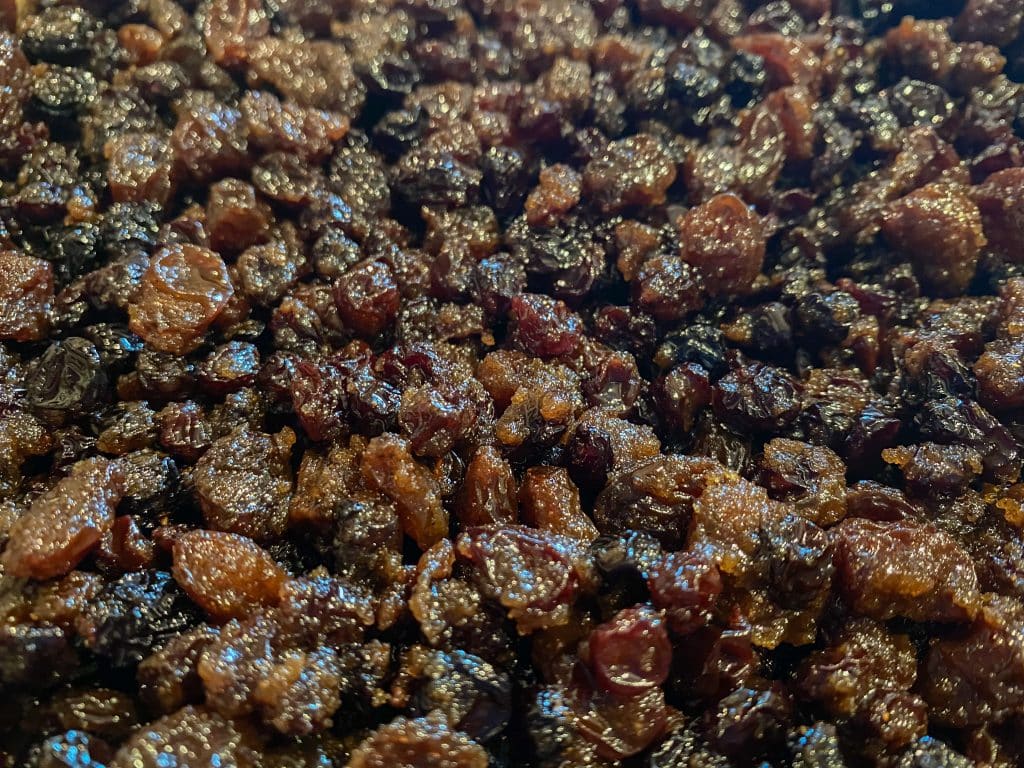
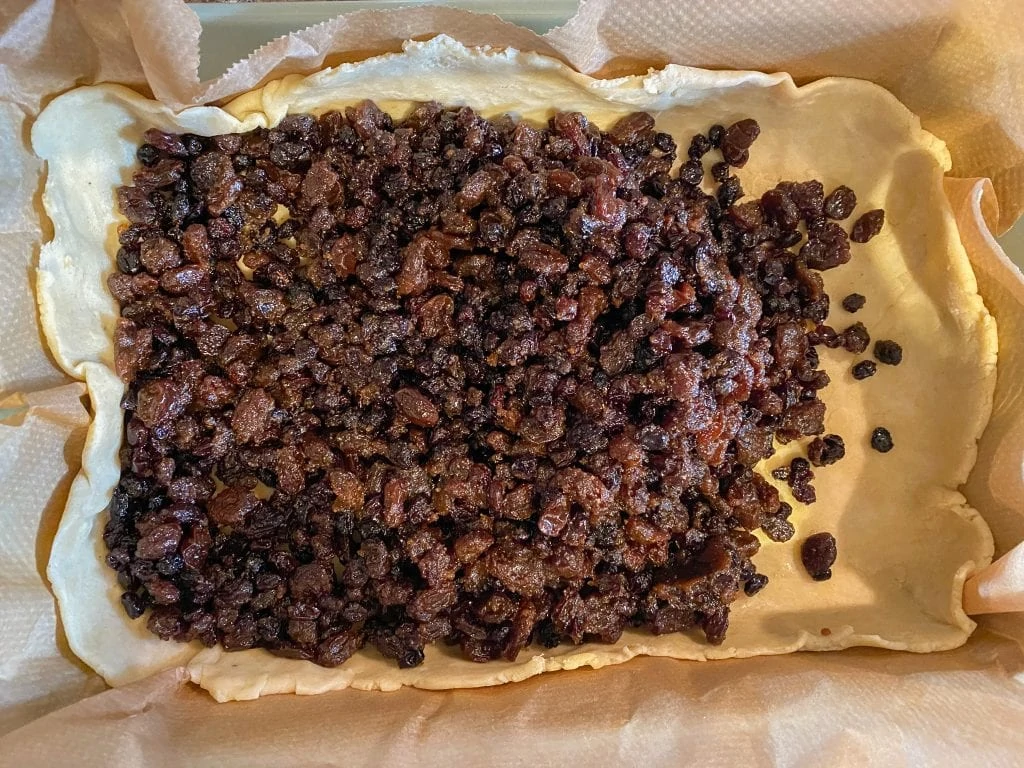
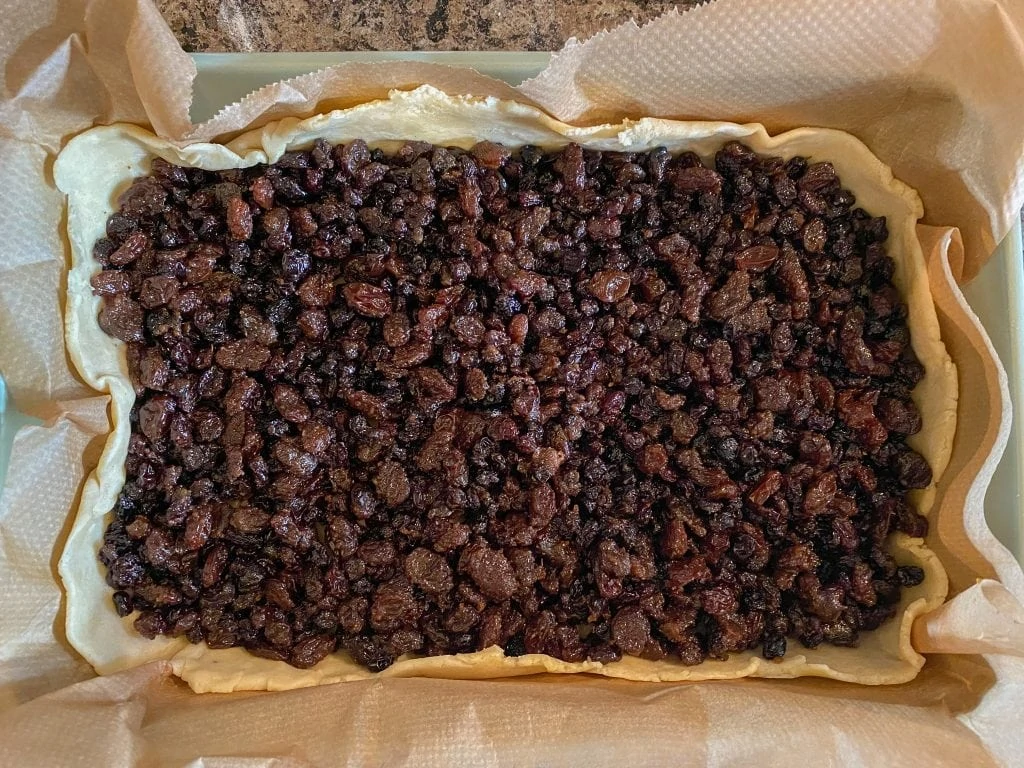
Roll out the remaining pastry for the “lid” of the fruit slice. Place over the top and press into the pastry on the sides. Don’t worry if it’s a little messy or thin in places as it’ll bake and come together just fine!
Put a few vertical slits on the top of the pastry to let out the steam. We usually do these where we intend to cut the slices after baking.
You can brush milk or an egg wash on the top of the pastry if you want a more golden colour on the pastry.
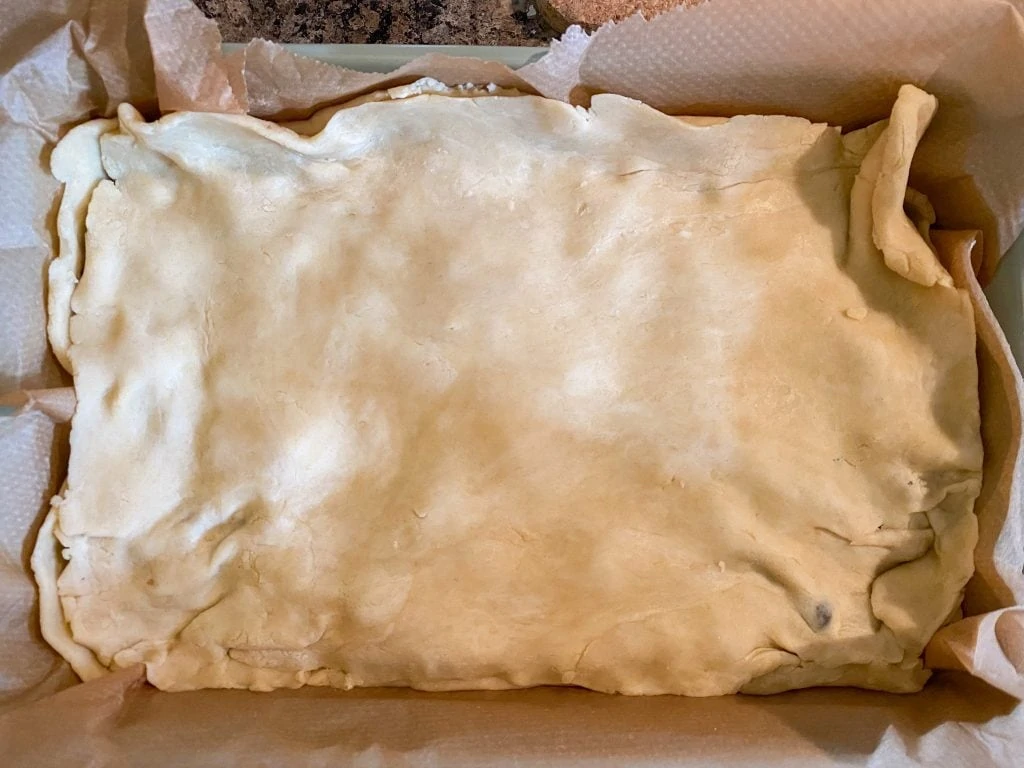
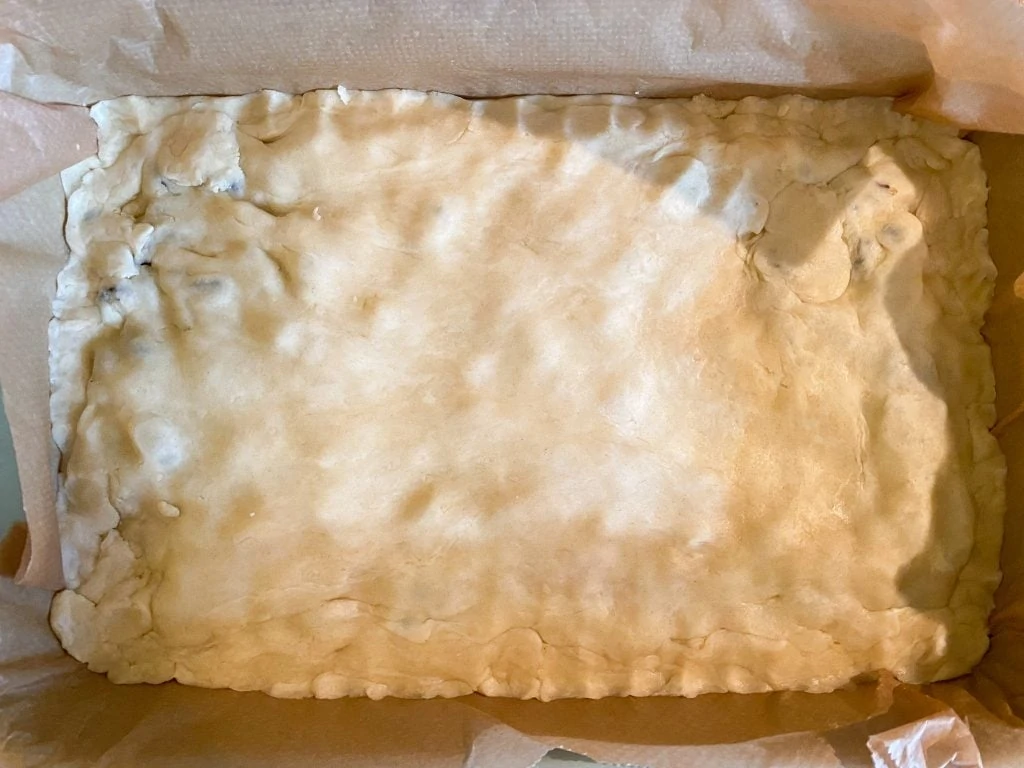
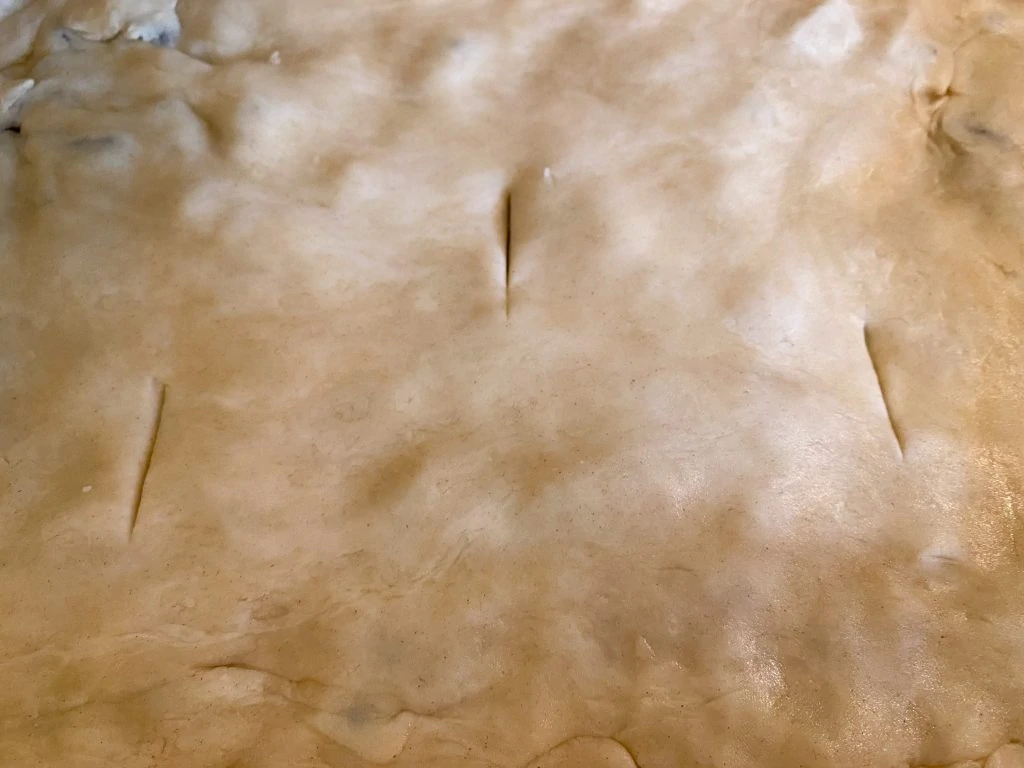
Put the baking tray into the pre-heated oven for approximately 45 minutes, checking from around 30 minutes to see if the pastry has started to brown. It should be a light golden colour on top.
When you take it out of the oven you can sprinkle a little caster sugar on top for extra sweetness.
Slice into squares while still warm (hence the Scottish Fruit Square name) and then serve warm or cold. Ideally with a cup of tea!
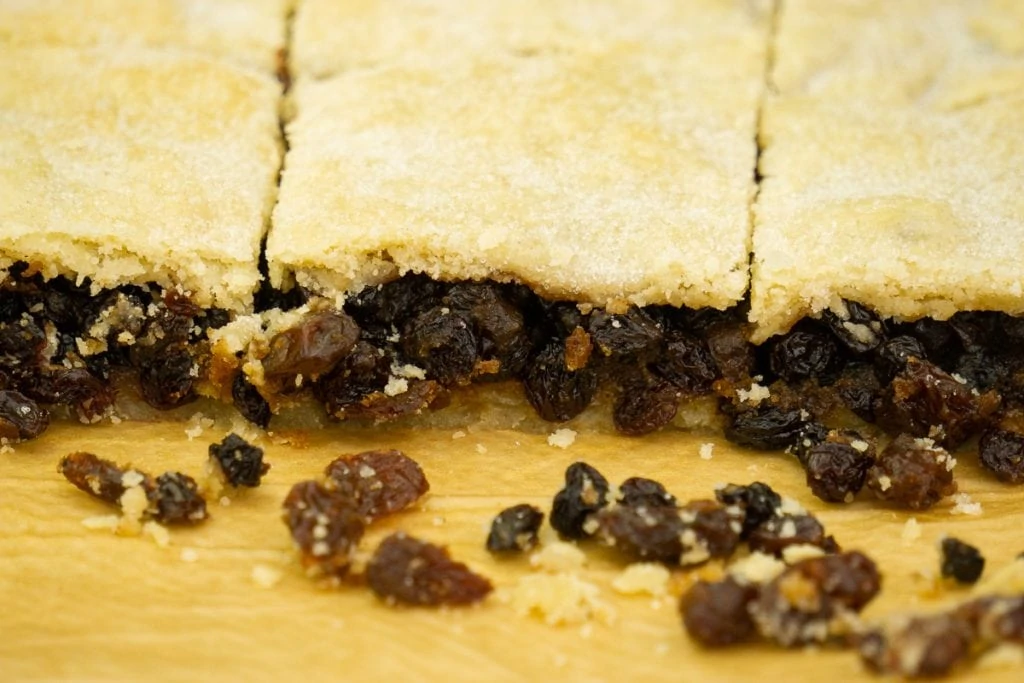
Variations
We have kept the currents and raisins relatively whole, so they resemble the “flies” that are the namesake of this baked delight. However, you could also allow them to soak a little and soften up in about a cup of boiling water and then add a tablespoon of cornflour when you add the melted butter and sugar.
A splash of Scotch whisky would also add an extra Scottish flair to the recipe. We know we say this for a lot of our Scottish recipes (like tablet) but it’s true.
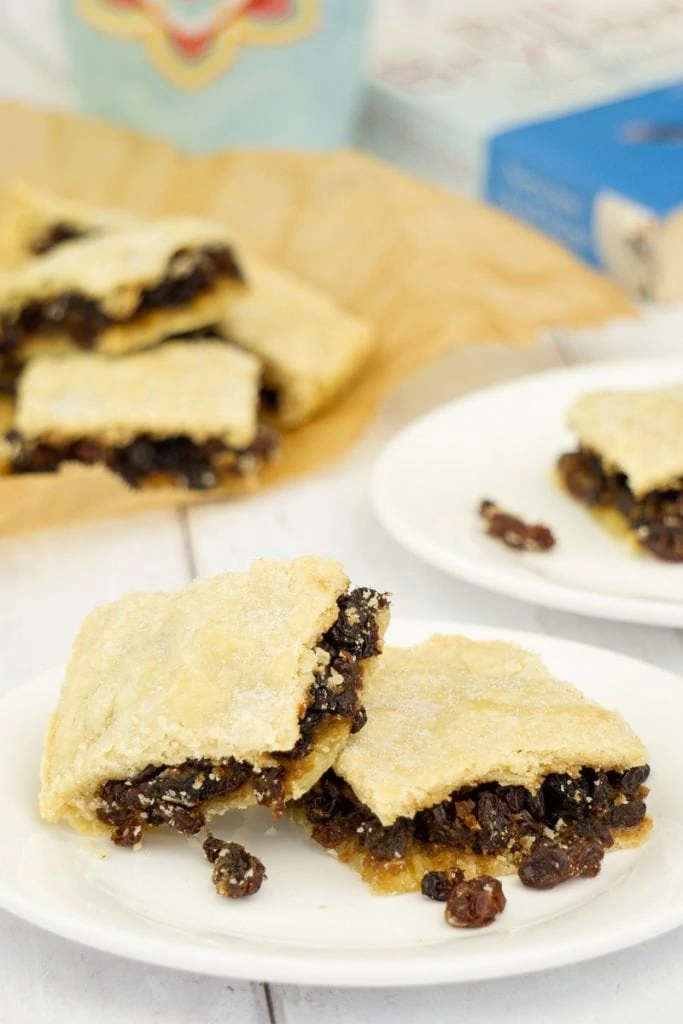
Flies' Graveyard: Scottish Fruit Slice Recipe
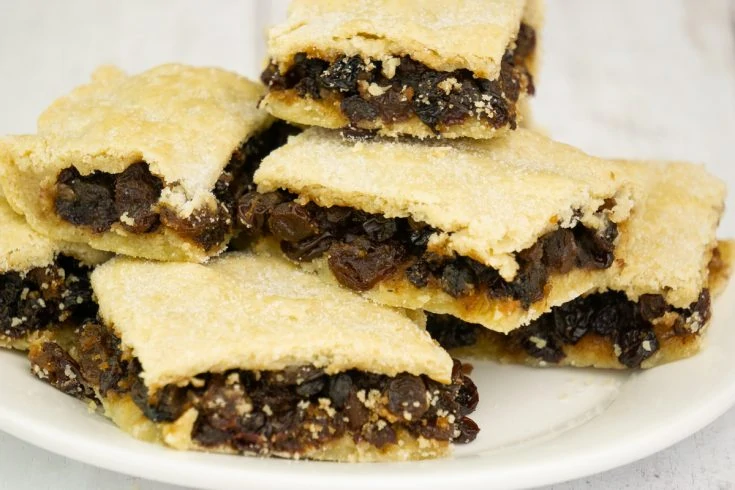
Flies' Graveyard, Flies' Cemetery, Scottish Fruit Slice, Fruit Square, whatever you want to call it! This easy bake is reminiscent of fruit mince pies, but it's a quick version to make and best enjoyed at any time of the year.
Ingredients
Shortcrust Pastry
- 300g plain flour (1 3/4 cups and 2 tbsp)
- 150g cold butter (2/3 cup)
- 75ml cold water (1/3 cup)
Filling
- 200g currants (1 and 1/3 cups)
- 200g raisins (1 and 1/3 cups)
- 50g butter (3.5 tbsp)
- 100g brown sugar (1/2 cup)
- 3tsp mixed spice
- Optional: Caster sugar to sprinkle on top
Instructions
- The first step is making the pastry. You need to use cold butter and cold water (best chilled in the fridge). If you have a mixer you can use that to mix the flour and butter. If not, put the flour in a bowl and then cut the butter into the flour using a pastry blender, two butter knives, or rub with fingertips to create a breadcrumb-like texture.
- Next pour in the cold water and use a butter knife to stir the mixture to bring it all together as much as possible.
- Tip on to a lightly floured surface and finish pulling the mixture together with your hands. Add a little extra flour if you need to but no more water. Don’t knead the pastry, try to handle it as little as possible, just as much as you need to bring it into a ball which you can then put in cling film and put in the fridge. Let it rest there for at least 15 minutes, up to 2 days.
- Preheat the oven to 180 degrees Celsius or 350 Fahrenheit.
- Next is the filling. Either use a microwave-safe bowl to melt the butter, or put it in a pan on the stovetop. Add the brown sugar, currants, raisins, and mixed spice, take off the heat and stir to combine. Allow it to cool while you roll out the pastry.
- Take the pastry out of the fridge and split it into two pieces, with one just a little bigger than the other. This is the one you’ll use for the base. Roll it out until it’s about 3mm, no more than 5mm, in thickness. You want the pastry to be about 1.5-2cm bigger in size than your baking tray so that it comes up the sides of the tray to form the edges of the slice.
- Line a 9inch by 12inch tray with baking paper and put the pastry in. Pour in the filling and spread evenly over the pastry.
- Roll out the remaining pastry for the “lid” of the fruit slice. Place over the top and press down into the pastry on the sides. Put a few vertical slits on the top of the pastry to let out the steam. We usually do these where we intend to cut the slices later.
- You can use a milk or egg wash on the top of the pastry if you want a more golden colour.
- Put in the pre-heated oven for approximately 40 minutes, checking from around 30 minutes to see if the pastry has started to brown. It should be a light golden colour on top.
- When you take it out of the oven you can sprinkle a little caster sugar on top for extra sweetness.
- Slice while still warm and then serve warm or cold.
Notes
We used a 9x12inch baking tray which was a perfect fit for the pastry when it was rolled thinly.
You can mix and match other dried fruits for the filling if you like, or even add a splash of whisky!
Nutrition Information:
Yield:
12Serving Size:
1Amount Per Serving: Calories: 341Total Fat: 14gSaturated Fat: 9gTrans Fat: 1gUnsaturated Fat: 4gCholesterol: 36mgSodium: 113mgCarbohydrates: 53gFiber: 2gSugar: 30gProtein: 4g
The nutritional data in this recipe is provided by a third party and these values are automatically calculated and offered for guidance only. Their accuracy is not guaranteed.

Sounds and looks delicious 😊 Here in New Zealand we call them Fly Cemeteries or Fruit Slice too! Obviously our ancestor’s brought the recipes over with them ☺
We’ve found this with lots of Scottish recipes! They’ve made their way around the world 🙂
Hi am I best using dark or light brown sugar
You can use either, it comes down to personal taste! Dark brown sugar usually has a little more depth of flavour and has a more caramel tasting flavour to it.
What are the ingredients in the mixed spice?
Hi Graham,
Mixed Spice is a balance of some or all of the following ground spices: cinnamon, coriander seed, caraway, nutmeg, ginger, cloves, allspice, and mace. You can replace it with Cinnamon and Nutmeg two parts cinnamon one part Nutmeg with a little mace.
Has anyone else from the US made this? I followed the instructions to the letter and even rolled the crust super thin and didn’t have enough crust for two layers in a 9×13 pan or enough filling. I’m wondering if the conversions are off a smidge?
Hi Jodi,
Thanks so much for your comment I’m so sorry you had this problem! We looked into it and the measurements are an accurate translation but we double checked our dish size and it was 12x8inches. It doesn’t seem like much difference but I think that must have been the problem. We’ve now changed the recipe to note this and say that if you have a bigger pan just add a quarter or half of the measurements again so that you’ll have plenty of dough and filling. Thank you for helping us to improve the recipe and I hope you’re able to enjoy it!
My Mother was born in Scotland and she called this a Raisin Square, she only used currants, no raisins. I make it at Christmas every year. I used a pre-made crust, as I am terrible at making crusts, it still comes out just fine. The good thing about a dead fly pie is you don’t have to be “exact” on the ingredients, and we never added an all-spice to it. Just have fun with it. I’ve had them turn out perfect, and I have had them turn out sloppy,, still tasted great !! Enjoy !
Thanks so much for sharing! That’s what we love about this recipe too, that you can play with it and see what works, or use what you have in the cupboard. Store bought pastry is often just as good, if not better!!
After finding this recipe, I attempted making it last night and am pleased with the results. I couldn’t find currants, so substituted gold raisins. And mixed spice isn’t easy to find in the states; I used pumpkin pie spice instead and liked the results.
Thank you for sharing the recipe!
Some great variations there Greg, so pleased they worked out for you!